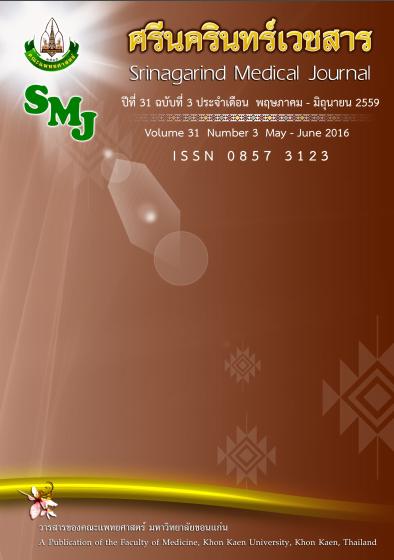Effects of Preanesthetic Evaluation with Video Information on Preoperative Anxiety in Patients Undergoing Surgery at Burapha University Hospital
Keywords:
preanesthetic evaluation, preoperative anxiety, video informationAbstract
Background and Objective: Prior to the operations, it had been known that waiting patients had a high level of anxiety. Patients had been provided with a plurality of doctor-patient communication in order to lessen their anxiety. In this regard, the objective of this study thus is twofold: first, to investigate the effects of preanesthetic evaluation with the video use on preoperative anxiety. Second, to compare the anxiety before and after this type of preanesthetic evaluation.
Methods: In this experimental research, there were 203 patient participants who underwent surgery and anesthesia at Burapha University Hospital. The anesthesia team performed preanesthetic evaluation on patients. The team talked and provided them with explanations. Then, the team had patients to watch video information about anesthesia. Their anxiety was measured by employing the 100 mm of Visual Analog Scale (VAS). The VAS scores of individual patients were measured and collected throughout all periods of measurement, accordingly. In this study, patients were told to rate their anxiety level for four periods: first, VAS was measured prior to preanesthetic evaluation (VAS before talk). Second,VAS was then collected after preanesthetic evaluation (VAS after talk).Third, it was after watching a video about the anesthesia in which VAS score was performed after a video session (VAS after video session). Fourth, it was on the day of surgery in which preoperative anxiety level was recorded before the surgery (VAS before surgery).
Results: According to the study, it was found that VAS after talk became low after patients talked to the preanesthetic evaluation team (mean = 31.63; SD = 28.53). This was also significantly low in a comparison to VAS before talk (mean = 37.54; SD = 31.45; p< 0.01). Regarding VAS after video session, it was also low (mean = 28.57; SD = 28.10). And, this anxiety decreased significantly when compared to VAS before talk and VAS after talk (p< 0.01). On the operation day, it was found that VAS before surgery grew (mean = 39.01; SD = 31.42). Nevertheless, it was normally low. Comparing the anxiety level, the VAS before talk was not significantly different from VAS before surgery.
Conclusion: To sum up, the use of preanesthetic evaluation jointly used with video information by the anesthetic team yielded the results that it could conceivably decrease the anxiety level in two preanesthetic periods, which were after talking to anesthesia team and after watching a video. However, this integrated use was firmly unable to significantly lower the preoperative anxiety among patients.




